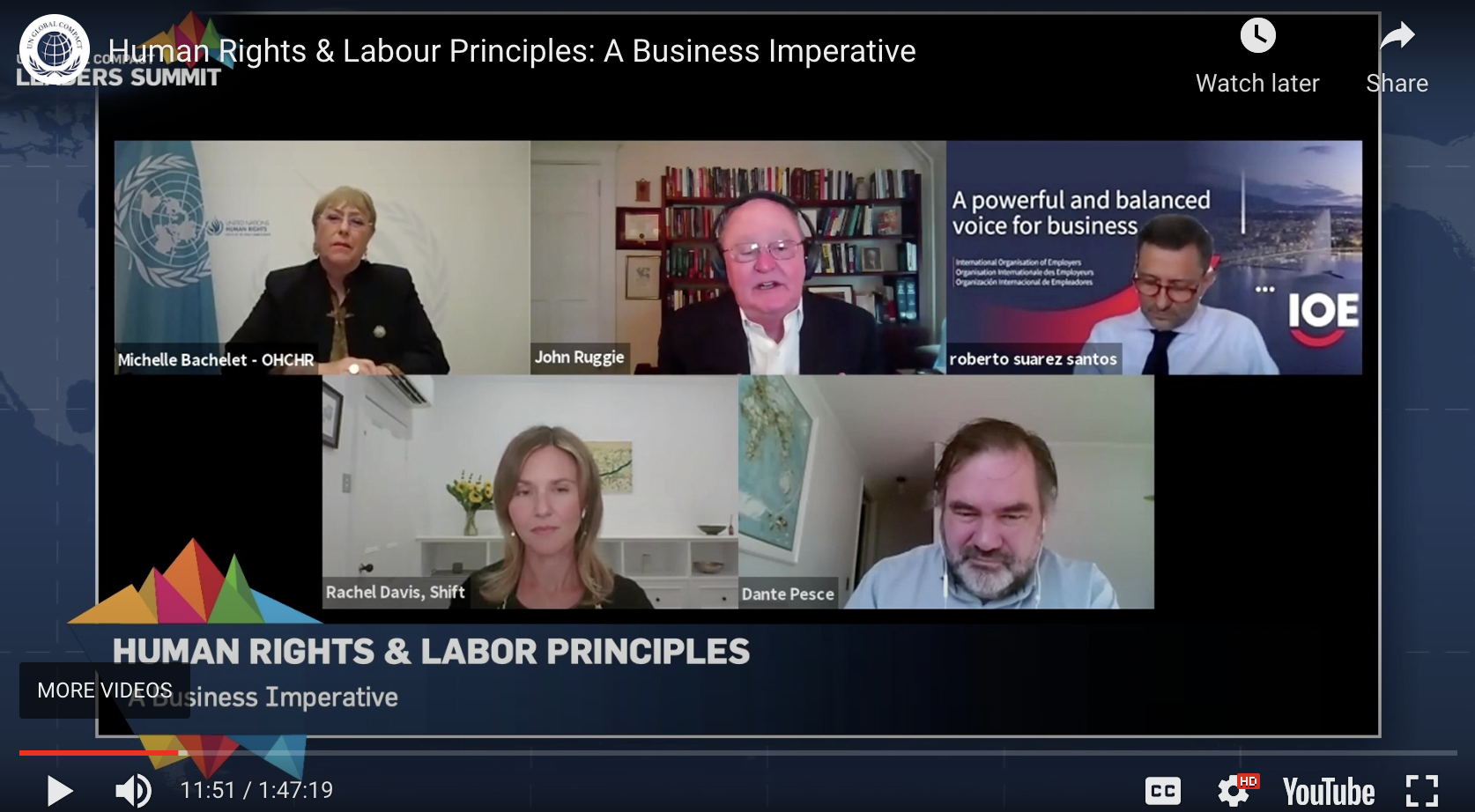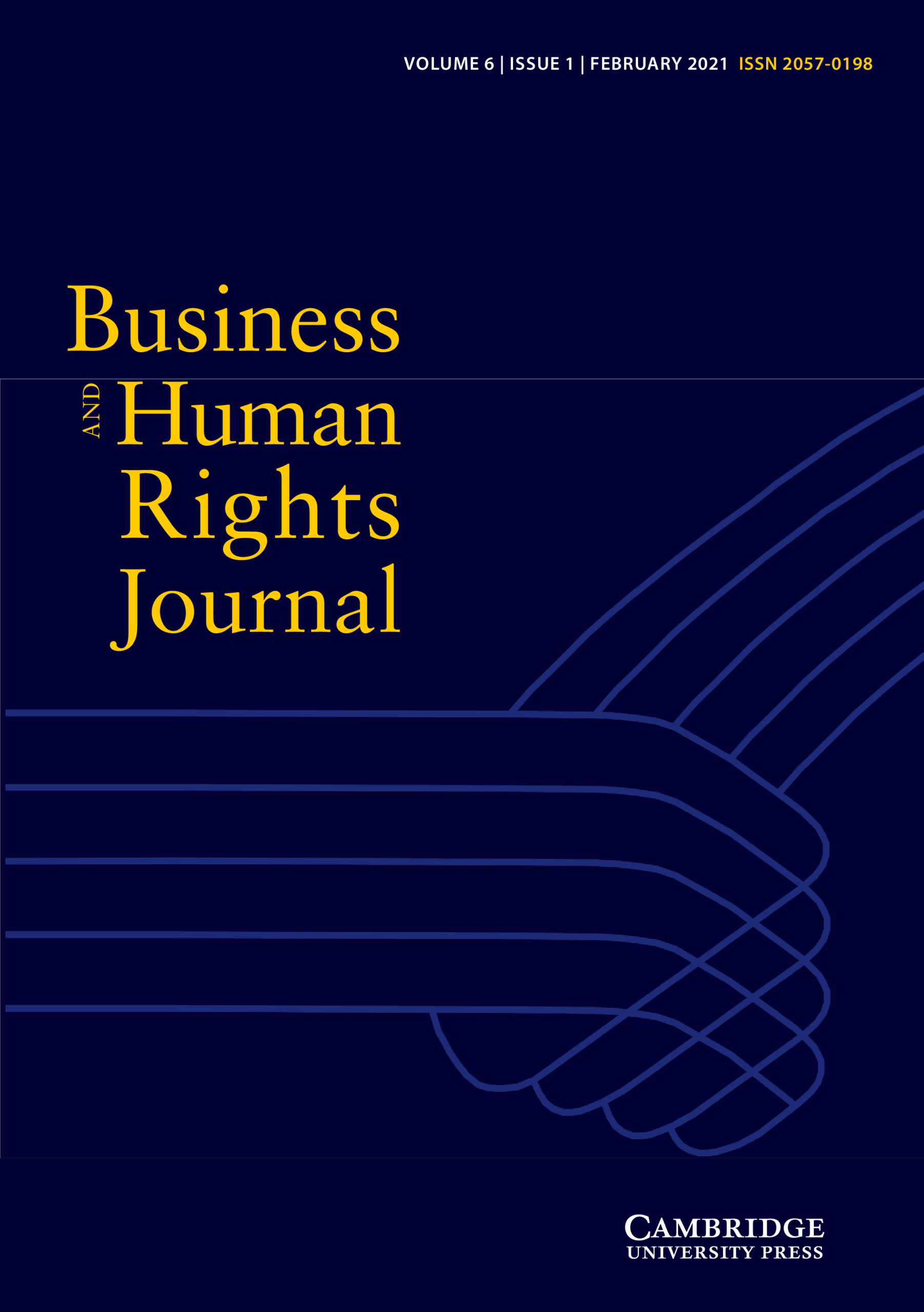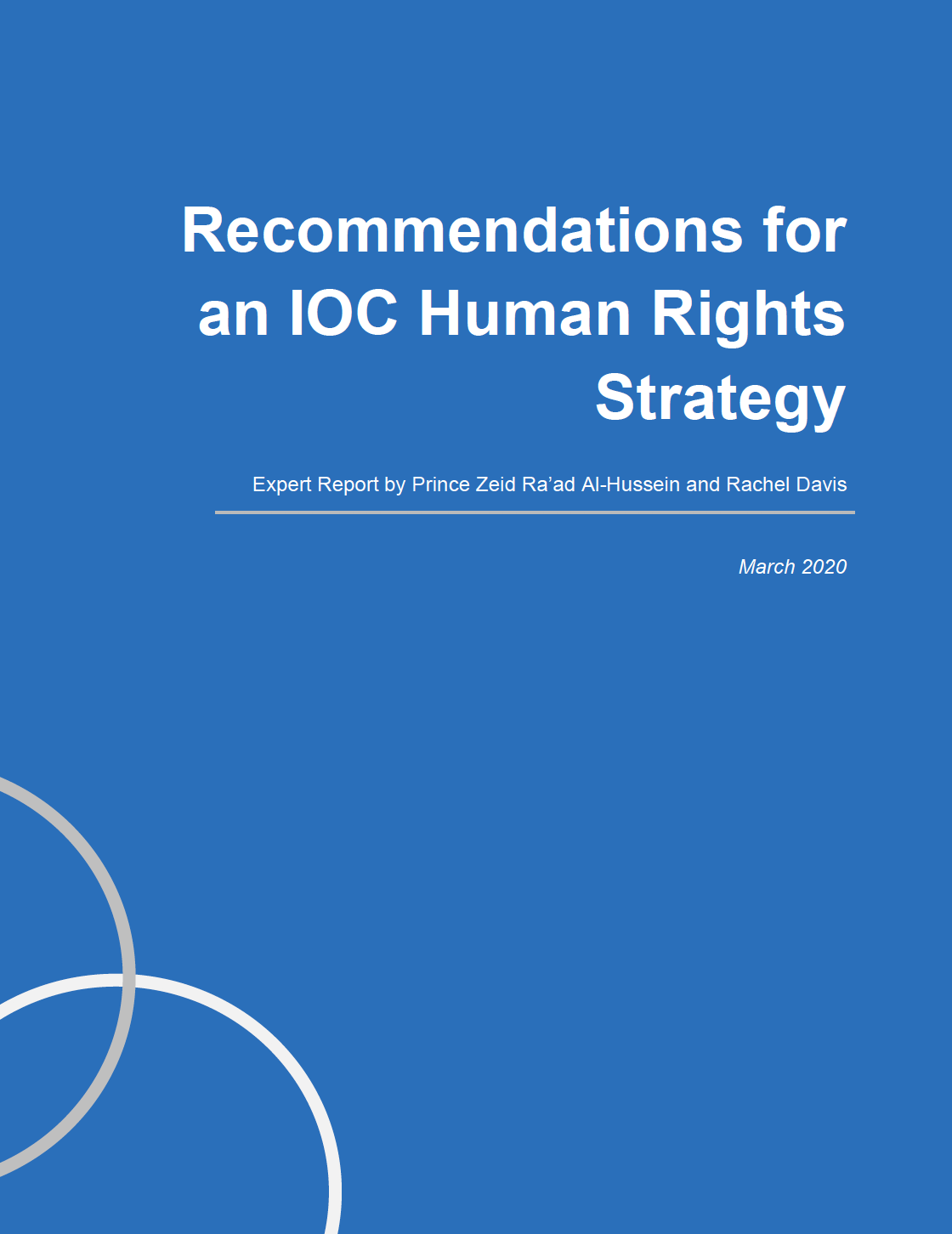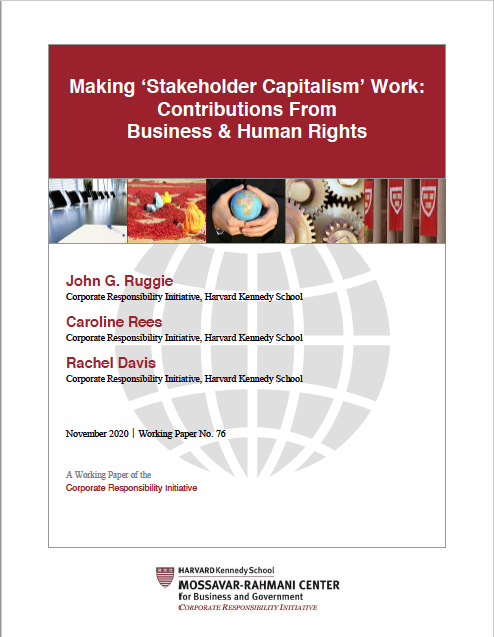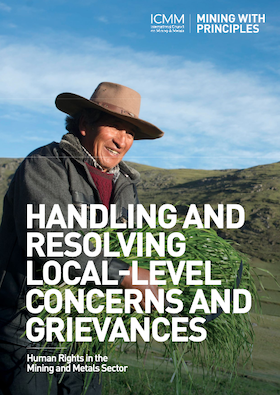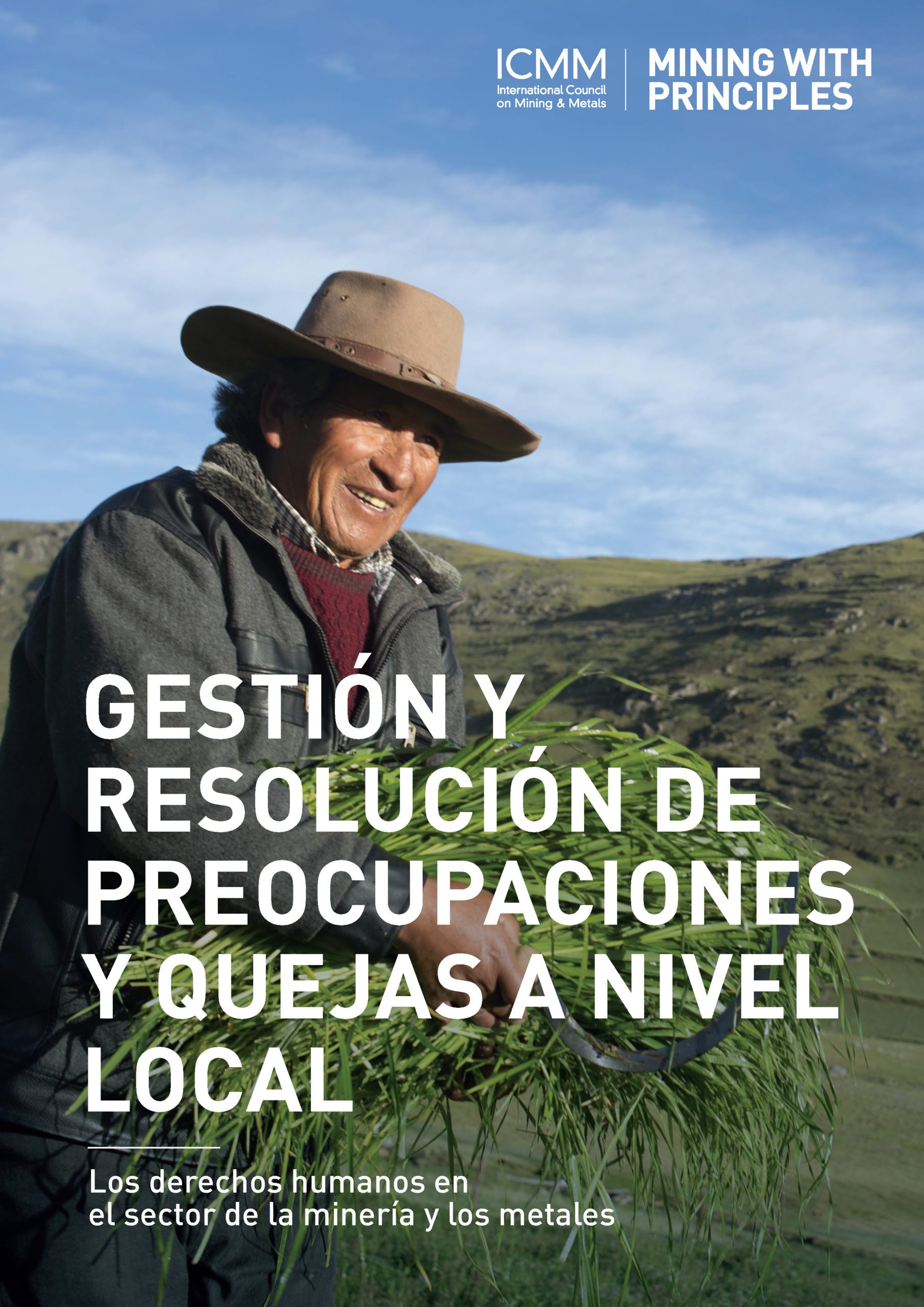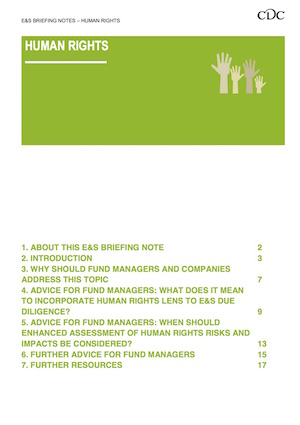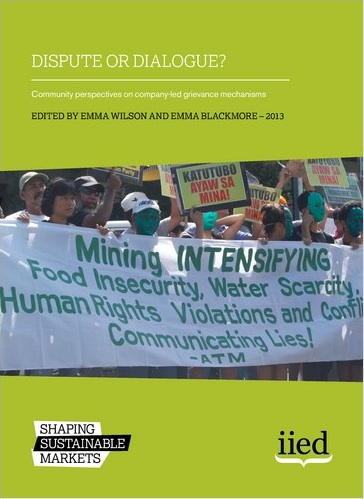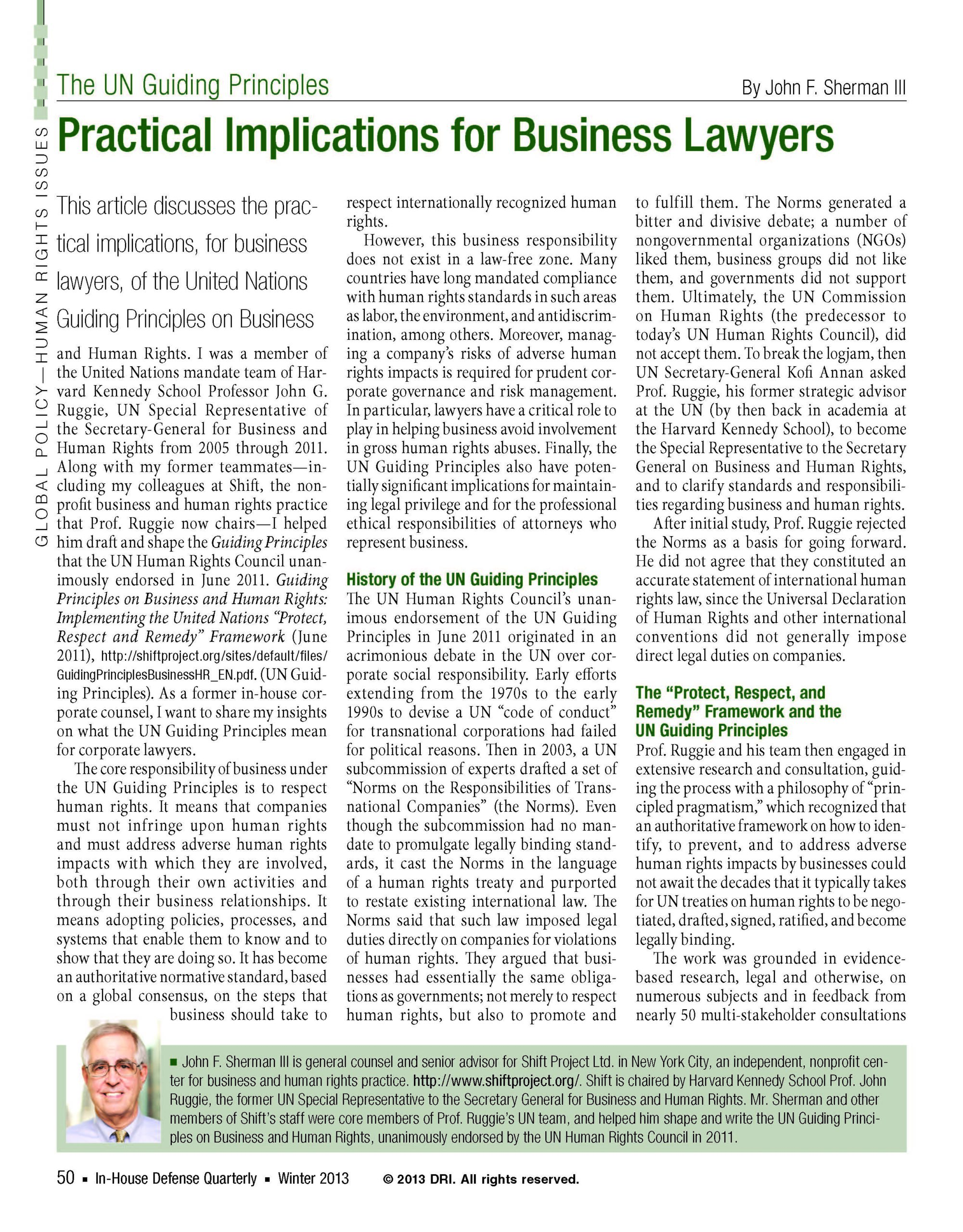This High-Level dialogue was hosted by the UN Global Compact in the context of the 10th anniversary of the UN Guiding Principles on Business and Human Rights. It was moderated by Shift’s Vice President, Rachel Davis. Panelists include the author of the UN Guiding Principles, John Ruggie; UN High Commissioner for Human Rights Michelle Bachelet; the Secretary-General of IOE, Roberto Suarez Santos; and the Chair of the UN Working Group on Business and Human Rights, Dante Pesce.
Resource Type: External Resource
Ten Years After: From UN Guiding Principles To Multi-Fiduciary Obligations
Ten years on from the UN Guiding Principles, the soft law of human rights due diligence has helped provide a path beyond shareholder primacy towards stakeholder governance. This is now influencing hard law, particularly in Europe. In this paper, Shift’s Chair, Professor John Ruggie, and our two co-founders, Caroline Rees and Rachel Davis explain the journey.
The paper is divided into five parts. The first recaps the current debate regarding the purpose of the corporation, which centers on whether and how stakeholder governance should and could supersede shareholder primacy. The second provides a brief backstory on shareholder primacy versus stakeholder governance. The third introduces the elements of HRDD and demonstrates that even in its soft law form it is bringing stakeholder concerns and corporate practice into closer alignment. Section IV describes how this experience with soft law is informing national and supranational legal requirements in a growing number of jurisdictions, with knock-on effects for corporate governance. The conclusion endeavors to draw some lessons from how, a mere decade after UN endorsement of the Guiding Principles, they have turned the idea that companies are responsible for preventing and addressing adverse impacts of their business on people’s basic dignity and equality into a mainstream proposition with significant implications for corporate governance while acknowledging that large gaps remain in the BHR space.
Summary of Recommendations for an IOC Human Rights Strategy
In March 2020, Shift’s Rachel Davis and the former UN Human Rights Chief, Prince Zeid Ra’ad Al Hussein, delivered the report ‘Recommendations for an IOC Human Rights Strategy’ to IOC President Thomas Bach. The report in full has been made publicly available by the IOC on the organization’s website. Below is a summary of the recommendations that were included in the report, grouped into five pillars.
The authors recommend:
1. Articulating the IOC’s human rights responsibilities, including by adopting appropriate amendments to the Olympic Charter and other core documents, developing a detailed human rights policy commitment reflecting the expectations of the UN Guiding Principles on Business and Human Rights, and setting similar expectations for the Olympic Movement as a whole through the “Basic Universal Principles of Good Governance of the Olympic and Sports Movement”.
2. Embedding respect for human rights across the organization to ensure that the IOC’s commitment is driven into its values and culture, including by: hiring a Head of Human Rights to lead implementation of a new human rights strategy, supported by a Human Rights Unit; establishing a cross-functional steering group on human rights at Director-level; ensuring the IOC’s governing bodies take full account of human rights in their decision-making (including through the role of the proposed Human Rights Advisory Committee); and ensuring that there is human rights expertise in the IOC’s consultative Commissions.
3. Identifying and addressing human rights risks by strengthening human rights due diligence across the IOC’s operations, including by: routinely integrating the perspectives of affected stakeholders (such as athletes, journalists, volunteers, fans, workers and local communities) into the process of identifying and taking action on human rights risks; significantly strengthening the way in which athlete voice and representation informs decision-making within the IOC and the Movement more broadly; taking a more robust approach to using the IOC’s leverage with National Olympic Committees and International Federations on human rights issues; and integrating a focus on salient human rights issues (such as child protection and respect for athletes’ human rights) into existing areas of the IOC’s work.
4. Tracking and communicating on the IOC’s progress, including by: evaluating the human rights performance of the IOC’s partners, especially that of OCOGs for upcoming editions of the Olympic Games; deepening the IOC’s engagement with affected stakeholders and their legitimate representatives (including trade union representatives where athletes are unionized), or with credible proxies for affected stakeholders’ views where direct engagement is not possible; and enhancing transparency about the IOC’s human rights efforts.
5. Strengthening the wider remedy ecosystem in sport by contributing to a significant improvement in the quality of grievance mechanisms at all levels of sport, including strengthening sports bodies’ own mechanisms, supporting social dialogue processes in sport, and enabling access to state-based forms of remedy for severe human rights harms. We recommended that this should begin with an initial focus on: improving access to remedy in cases of harassment and abuse; improving Games-time grievance mechanisms (run by the IOC as well as by OCOGs); and reviewing the preparedness of the IOC’s own systems to handle human rights complaints.
ABOUT THE AUTHORS
Zeid Ra’ad Al Hussein was the UN human rights chief from 2014-2018; and is a highly-regarded defender and promoter of universal human rights -awarded the Stockholm prize in 2015 as well the Tulip prize in 2018 for his human rights work. For much of his career, he was a senior diplomat, serving twice as Jordan’s ambassador to the United Nations (in New York) and once as Jordan’s ambassador to the United States (2007-2010). He also represented Jordan twice before the International Court of Justice (ICJ). In January 2014, he served as president of the UN Security Council. Earlier, in 2002 he was elected the first president of the governing body of the International Criminal Court (ICC) — guiding the court’s growth in its first three years (9/2002-9/2005). He chaired some of the most complex legal negotiations associated with the court’s statute. He contributed to the international community’s efforts at countering the threat of nuclear materials being trafficked by terrorists (2010-2014). And he led the UN’s efforts at eliminating sexual exploitation and abuse in UN peacekeeping (2004-2007). From 1994-1996, he was a UN civilian peacekeeper with UNPROFOR. He has degrees from Johns Hopkins and Cambridge universities. In 2019, he was appointed a member of The Elders, an independent group of global leaders working for peace, justice and human rights, founded by Nelson Mandela. He is currently the Perry World House Professor of the Practice of Law and Human Rights at the University of Pennsylvania. In 2019, he was inducted into the American Academy of Arts and Sciences and awarded an honorary knighthood (KCMG) from Queen Elizabeth II.
Rachel Davis is Co-founder and Vice President of Shift, the leading center of expertise on the UN Guiding Principles on Human Rights, where she has led work for the last decade on standard-setting, human rights and sports, financial institutions, conflict and international law. Rachel has been the Chair of FIFA’s independent Human Rights Advisory Board since it was established in 2017 and has advised the International Olympic Committee on human rights since 2018. She was a senior legal advisor to the Special Representative of the UN Secretary-General on business and human rights, Harvard Professor John Ruggie (2006-2011), and is a Senior Program Fellow with the Corporate Responsibility Initiative at Harvard Kennedy School. An author of the leading study on the costs of company-community conflict in the extractive sector, Rachel has worked at the High Court of Australia and the UN International Criminal Tribunal for the former Yugoslavia. She is a graduate of Harvard University and the University of New South Wales.
Making ‘Stakeholder Capitalism’ Work: Contributions from Business & Human Rights
For the first time in four decades, leading business associations, corporations, and the corporate law and governance community are seriously debating the social purpose of the corporation. The idea of stakeholder governance – moving beyond shareholder primacy toward some form of ‘stakeholder capitalism’ – is in play. But the how question unveils significant differences of opinion as well as difficulties. Some advocates place their bet on enlightened voluntary cooperation between corporations, large institutional investors, and other stakeholders. Yet considering the financial incentives, the current system affords corporate directors and executives, especially in the Anglo-American system, driven by equity-based compensation, voluntarism by itself is unlikely to move the needle far enough. Others provide long and detailed lists of a dozen or more bodies of law and regulations that should be reformed to ensure that accountability to wider stakeholders is established. But that inevitably poses multiple political impediments and therefore takes time. For their part, critics of ‘stakeholderism’ posit what amounts to an impossibility theorem, contending that corporate leaders simply are unable to identify ex ante who the relevant stakeholders are, or to devise a formula regarding how to weigh and balance their conflicting interests – let alone how their concerns would be represented at board levels.
In contrast, we focus on a pathway that reflects the ambition of stakeholder capitalism, but which current reform proposals have largely overlooked. We draw on practical experience in the field of business and human rights, where leading companies are increasingly embedding human rights due diligence processes into their strategic decision-making. As human rights due diligence is made mandatory for companies, which it is in a growing number of jurisdictions – with debate centered in but not limited to Europe – risks to stakeholders become a significant corporate governance issue. It makes it necessary that their concerns are addressed and requires demonstration that indeed they are. Such changes by themselves may not constitute a full-blown system of multi-fiduciary obligations, but they mark substantial strides on the path toward it, and they are doing it in the relatively near-term.
Handling and Resolving Local-Level Concerns and Grievances
Shift worked with ICMM in 2018 and 2019 to update the guidance they provide to their members on how to put in place effective operational-level grievance mechanisms, in line with the effectiveness criteria of the UN Guiding Principles. Our role included co-facilitating workshops with ICMM members; developing case studies with the support of ICMM members and inputting into the new guidance.
SPANISH
Esta guía incluye 8 criterios de eficacia para los mecanismos de queja a nivel de la operación, tal como lo establecen los Principios Rectores de las Naciones Unidas sobre las Empresas y los Derechos Humanos, estándar internacional para los negocios y los derechos humanos.
También comparte pautas sobre cómo las compañías mineras y metalíferas deben diseñar mecanismos efectivos que brinden un sistema para gestionar y resolver las preocupaciones o quejas de las comunidades, y proporciona herramientas prácticas para ayudar a las compañías en su implementación.
ENGLISH
Shift worked with ICMM in 2018 and 2019 to update the guidance they provide to their members on how to put in place effective operational-level grievance mechanisms, in line with the effectiveness criteria of the UN Guiding Principles. Our role included co-facilitating workshops with ICMM members; developing case studies with the support of ICMM members and inputting into the new guidance.
ESG Toolkit for Fund Managers: Briefing Note on Human Rights
This resource, developed with support from Shift, explains the relationship between human rights and traditional environmental and social due diligence. It aims to provide fund managers with a practical introduction to human rights issues that may be relevant to their investments. It gives fund managers:
- A clear understanding of what human rights risks and impacts are, why they are important and how they relate to traditional environmental and social (E&S) risks and impacts;
- A practical approach to integrating human rights lens into existing E&S due diligence approaches, aligned with international standards.
Dispute or Dialogue? Community Perspectives on Company-Led Grievance Mechanisms
This book includes a foreword and overview chapter authored by members of the Shift team. The summary below is excerpted from the resource.
Summary
What is a company– community grievance mechanism?
We define a company–community grievance mechanism as a process or set of processes for receiving, evaluating and addressing grievances from affected communities, in a timely and consistent manner at the site or operational level. The mechanism may be wholly or partially run by the company. Grievances might be real or perceived: the latter may be a source of acute anxiety for communities and can be addressed through dialogue and provision of timely and accurate information.
Extractive industry companies and their investors increasingly see a strong business case for building good relations with local communities, and addressing conflict and potential conflict in a timely and effective manner. This involves engaging meaningfully with communities affected by project operations, so as to build trust and to respond appropriately to any local concerns, major or minor. If left unaddressed even minor complaints may escalate into disputes or even violent conflict. This is potentially devastating for local communities. From the company perspective, it can also result in damage to its reputation, a loss of operational time and money, and it can put future investment opportunities at risk.
Effective channels by which local communities can voice their concerns about a project — and get these concerns addressed — are particularly important. In general the only formal mechanisms by which citizens can challenge the activities of extractive companies tend to be those available under host country legislation. However, courts and tribunals in host countries, particularly in developing countries and emerging economies, can be inefficient, corrupt or reluctant to interfere with extractive industry activities (Schwarte and Wilson, 2009). This can result in increased conflict and resentment among host communities, which may be a key legacy challenge when one company acquires a project from another.
Leading oil and gas, mining and forestry companies are starting to establish their own formal mechanisms to address and resolve local citizens’ grievances. Grievance mechanisms provide a channel for concerns to be identified and addressed before they escalate. As part of an effective overall community engagement strategy, they can help to build trust with stakeholders, reduce operational risks and enhance management of project impacts and community relations.
Frequently companies establish grievance mechanisms in order to comply with the formal requirements of project finance and international certification initiatives, which address conflict resolution and human rights protection. Since 2006, for example, the International Finance Corporation (IFC) requires its clients — companies that receive project finance — to set up and administer procedures to address project-related grievances from affected communities. Other international financial institutions have similar requirements. The environmental management systems standard ISO 14001 of the International Organization for Standardization (ISO), and the Forest Stewardship Council (FSC) certification standard both require certified companies to establish company–community grievance mechanisms.
More recently, a major influence on the adoption and development of grievance mechanisms, and on public awareness, has been the work of Professor John Ruggie in his role as UN Special Representative on Business and Human Rights, and the UN Human Rights Council’s endorsement of the UN Guiding Principles on Business and Human Rights (UN/OHCHR, 2011) (see Chapter 2).
There is a growing body of literature on company– community grievance mechanisms, supported by online resources such as BASESwiki (transferred to the ACCESS platform in 2013).
In general, there is a need for more long-term analysis of the implementation, impact and effectiveness of grievance mechanisms, including analysis of the broader societal impacts beyond day-to-day resolution of grievances. Having identified in particular a lack of material on the community perspectives on company-led grievance mechanisms — their effectiveness and impact on sustainable development and livelihoods locally — IIED sought to address this by undertaking and commissioning the research in this book, with case studies based on a mix of desk-research, interviews and fieldwork.
Chapter 2 is a review of the current literature and experience of grievance mechanisms. Based on desk-research and interviews with company and industry experts, it explores definitions of the term ‘grievance mechanism’; some history behind the evolution of grievance mechanisms including alternative dispute resolution; key drivers, standards and guidance for their design and use; and consideration of future trends in grievance mechanism development. This is followed by a series of four chapters focusing on case studies in the oil and gas, mining, and forestry sectors.
Chapter 3 covers the grievance mechanism run by BP in Azerbaijan for the 1,768km Baku–Tbilisi– Ceyhan (BTC) pipeline, which passes through Azerbaijan, Georgia and Turkey. The BTC pipeline project has been the focus of considerable international scrutiny by civil society organisations and project lenders, due to its size and impact and international profile. The project has benefited from investing in civil society capacity building during the construction phase, which has enabled informed dialogue between the company and civil society over the years. The case study highlights the need to balance government and company responsibilities in resolving grievances. It also demonstrates how a major international project such as this can positively influence government practice.
Chapter 4 is a case study of the company Congolaise Industrielle des Bois (CIB), which manages around 1.4 million hectares of tropical forest concessions in the northern Republic of Congo. The company achieved its first FSC certificate in 2006 and full certification in 2010. FSC has been a key driver for CIB to establish a grievance mechanism for resolving land-related disputes and for providing fair compensation for loss or damage to property, livelihoods and resources. This case study demonstrates how grievance mechanisms can be based on existing community structures and underscores the need to respect traditional conflict resolution approaches.
Chapter 5 relates to the Sakhalin-2 oil and gas project in the Russian Far East. Like the BTC project, Sakhalin-2 has used project finance, and has come under considerable international scrutiny and criticism, but is also seen as a pioneer of community engagement in Russia. This case study analyses the experience of the operating company, Sakhalin Energy, in addressing grievances and building a dialogue with the indigenous peoples in the north of the island. This is then compared to a conflict that has developed with a (non-indigenous) dacha community located close to a liquefied natural gas plant in the south of the island. The case study provides an example of a well-functioning grievance mechanism, but highlights the need to understand the full range of complexities associated with building dialogue with communities, including outside the grievance resolution process.
Chapter 6 considers the effectiveness of three different grievance mechanisms and stakeholder engagement processes implemented by mining companies. The first is Anglo American’s approach to stakeholder engagement, its grievance mechanism and the computerised system employed to manage grievances. The second is TVIRD in the Philippines, which demonstrates the value of building on local and traditional modes of communication and dispute management to create culturally appropriate grievance mechanisms. The third case, Kaltim Prima Coal in Indonesia, illustrates the ‘governance gaps’ that exist in a number of developing countries that a company–community grievance mechanism can help to fill.
The book’s findings demonstrate the importance of having an open and responsive overall approach to stakeholder engagement within which a grievance mechanism can be employed effectively. The book offers examples of successful approaches for enhancing dialogue — from civil society capacity building to designing engagement around traditional decision-making processes, as well as system innovations such as electronic logging, which facilitate the monitoring and management of grievance resolution within the company. The book considers community conflict with an eye to understanding the mechanics and the challenges of how company– community engagement takes place in practice. It also offers local perspectives on the implementation of standards and processes that are frequently analysed primarily at the level of system or process. As such the book offers a fresh take on a growing body of literature on company–community grievance mechanisms.
The UN Guiding Principles: Practical Implications for Business Lawyers
This article, available here courtesty of its original publisher In-House Defense Quarterly, focuses on the significance and implications of the Guiding Principles for corporate lawyers and the role of lawyers in meeting client business goals while respecting human rights.
